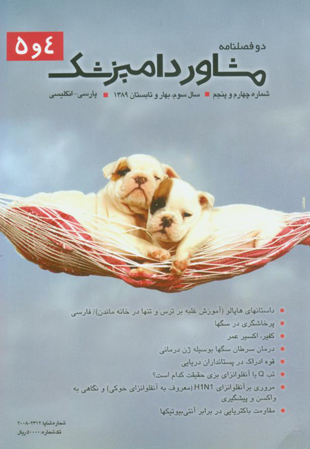فهرست مطالب

دو فصلنامه مشاور دامپزشک
پیاپی 4-5 (بهار و تابستان 1389)
- 128 صفحه، بهای روی جلد: 50,000ريال
- تاریخ انتشار: 1389/07/20
- تعداد عناوین: 9
-
صفحه 5
- نوشتارها
-
صفحه 27
-
صفحه 37
-
صفحه 59
-
Page 27The two most common behavioral problems in dog are those associated with aggression, primarily dominance aggression, and those associated with fears and anxieties (and most aggressions may be anxiety disorders).With all cases of canine aggression, it is important to know the potential risk of the dog. The exact degree of risk varies with the size of the dog, type and severity of the aggression, ability of the owners to adequately restrain the dog, and use of special equipment such as muzzles and head collars. Risk is also affected by the presence or absence of especially vulnerable individuals (children, elderly), or pets that are substantially smaller than the aggressor. The aim of this paper is to familiarize owners and practitioners with different type of aggression in dog and to help them manage these conditions.
-
Page 37Kefir (alternately kefīrs, keefir, kephir, etc), purportedly from either the Turkish "keyif" (joy/pleasure) or "köpür" (milk) froth, foam) or from the Persian "kef" (foam) and "shir" (milk), is a fermented milk drink that originated with shepherds of the Caucasus region, who discovered that fresh milk carried in leather pouches would occasionally ferment into an effervescent beverage. It is prepared by inoculating cow, goat, or sheep's milk with kefir grains. grains are a combination of bacteria and yeasts in a matrix of proteins, lipids, and sugars. This symbiotic matrix forms "grains" that resemble cauliflower. Many different bacteria and yeasts are found in the kefir grains, which are a complex and highly variablecommunity of micro-organisms termed probiotics. Kefir has antimutagenic and antiapoptisis antioxidant properties, and can possibly be used to prevent mutagenic and oxidative damage in the human body One can change the nutrient content by simply fermenting for shorter or longer periods. Kefir has many reputed health benefits. It has antibiotic and antifungal properties. Manystudies, in both animals and humans, have demonstrated immunestimulatingeffects from yogurt varieties that contain live cultures such as Lactobacillus acidophilus and other probiotics (we can say friendly bacteria). The effects observed in humans include an increase in the activity of several types of white blood cells.Supplements of Lactobacillus acidophilus and other friendly bacteria may help protect the intestinal tract from colonization by harmful organisms that can cause local or systemic infection. The effective amount of acidophilus depends on the strain used, as well as the concentration of viable organisms it contains. Infectious diarrhea in children has been successfully reduced with supplements of friendly bacteria such as L. acidophilus. So nowadays keffir has been used in the treatment of a variety of conditions, including metabolic disorders, atherosclerosis, and allergies, tuberculosis, cancer, poor digestion, candidiasis, osteoporosis, hypertension, HIV and heart disease.
-
Page 51Brandy, a 12 Year old yellow Labrador retriever, has been through a lot in the last two years of her life. Brandy's owners noticed the dog was limping; trying to Keep her weight off her right rear leg. An Examination led Brandy's veterinarian to suspect Cancer.Brandy was diagnosed with osteosarcoma – bone cancer. The retriever's right rear leg was amputated and she was given chemotherapy.Dr Elmslie and Dr Steven Dow, DVM, Ph.D for the past six years has been evaluating gene therapy for the treatment of cancer. The gene interleuken 2 showed promising results. This form of immunotherapy involves combining interleuken 2 with a fatty acidcalled a lipid. It is given intravenously to dogs diagnosed with osteosarcoma. The gene combined with the lipid is able to target the lung tissues. The intravenous therapy has had a significant effect on Brandy. After 12 weeks, the tumors in her lungs were notablysmaller than they had been six weeks earlier. Brandy has been receiving gene therapy for more than a year, and the lung tumors are extremely small.
-
Page 59Marine mammals are a diverse group of mammal that are primarily ocean-dwelling. They include the cetaceans (whales, dolphins and porpoises), the sirenians (manatees and dugong), the pinnipeds (true seals, eared seals and walrus), and several otters (the sea otter and marine otter). The polar bear is also usually grouped with the marine mammals.Perceptive power in marine mammals is so wonderful. Hearing for any animal is an important sense. Many sensory cues are limited in their distribution and utility. Sound however is literally universal While many animals inhabit lightless environments and are blind. For marine mammals, hearing is arguably their premier sensory system. Dolphins and whales devote more neurons to hearing than any other animals. The temporal lobes, which control higher auditory processing, dominate their brain and they appear to havefaster auditory and signal processing capabilities than any other mammal. Since the late 1950's we have been aware that dolphins, at least, use very high ultrasonic signals as a form of biosonar. Using sound they can distinguish amongst different metals and detectdifferences as small as a few mm in two objects.In the 1959, the United States Navy established a marine mammal program. Marine scientists found that the dolphin's keen sense of echolocation was ideal for finding lost equipment on the sea floor and for locating enemy mines and torpedoes. Although dolphins and sea lions are the only marine mammals currently used in military operations. two major groups of marine mammals, the whales and seals, do not possess any blue cones; they only have green cones and hence are colour-blind.cetaceans have a poor sense of smell but use taste to detect chemicals on the water.
-
Page 73Q fever is a globally zoonotic disease caused by Coxiella burnetii, a bacterium that Affects humans and other animals. This organism is uncommon but may be found in cattle, sheep, goats and other domestic mammals, including cats and dogs. The infection results from inhalation of contaminated particles in the air and from contact with the milk, urine,feces, vaginal mucus, or semen of infected animals. The incubation period is 9–40 days. It can be considered the most infectious disease in the world, as a human being can be infected by a single bacterium. The bacterium is an obligate intracellular pathogen.Incubation period is usually 2 to 3 weeks. The most common manifestation is flu-like symptoms with abrupt onset of fever, malaise, profuse perspiration, severe headache, myalgia (muscle pain), joint pain, loss of appetite, upper respiratory problems, drycough, pleuritic pain, chills, confusion and gastro-intestinal symptoms such as nausea, vomiting and diarrhea.
-
Page 89Swine flu is a respiratory infection caused by influenza viruses that regularly causeOutbreaks in pigs. Symptoms appear to be similar to the symptoms of regular human flu but it can vary from mild to severe and may aggravate underlying chronic medical Conditions. In the past, complications from swine flu have included pneumonia anddifficulty breathing. flu viruses can be directly transmitted between pigs and people. Human-to-human transmission is also possible, and appears to be occurring with this outbreak. As a matter of fact Influenza spreads between humans through coughing or sneezing and people touching something with the virus on it and then touching their own nose or mouth. So anyone who has contact with an infected person may be exposed to swine flu. Two antiviral drugs, Relenza and Tamiflu, appear to be effective in treating symptoms of this strain of the H1N1 virus.Methods of preventing the spread of influenza among swine include facility management, herd management, and vaccination. Recommendations to prevent spread of the virus among humans include using standard infection control against influenza. This includes frequent washing of handswith soap and water or with alcohol-based hand sanitizers, especially after being out in public. Chance of transmission is also reduced by disinfecting household surfaces, which can be done effectively with a diluted chlorine bleach solution.
-
Page 105Veterinary use of antimicrobials is now very substantial in all fields of animal industry, in pets and in animal conservation. Veterinarians face the dual problems of developing antimicrobial resistance and concerns from human medicine about the potentialfor animal use to drive this process and make human products less effective. This is of course a two-way process, but veterinary treatment is already prejudiced by the appearance of organisms such as multi-resistant Staphylococcus aureus, Escherichia coli and Pseudomonas aeruginosa. The appearance of multi-resistant S.intermedius and its recognition now in the world is a particular concern. With a lack of new and potent antimicrobials in the pipeline we are facing a crisis which can only be faced by much wiser use of the drugs that we have. This paper try to introduce thisphenomenon and it is to be hoped that this paper will help veterinarians to optimize their antimicrobial treatment practices and protocols.


